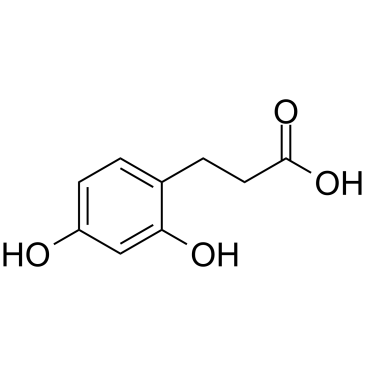3-(2,4-Dihydroxyphenyl)propionic acid

3-(2,4-Dihydroxyphenyl)propionic acid structure
|
Common Name | 3-(2,4-Dihydroxyphenyl)propionic acid | ||
|---|---|---|---|---|
| CAS Number | 5631-68-5 | Molecular Weight | 182.173 | |
| Density | 1.4±0.1 g/cm3 | Boiling Point | 418.0±14.0 °C at 760 mmHg | |
| Molecular Formula | C9H10O4 | Melting Point | 158-162ºC | |
| MSDS | Chinese USA | Flash Point | 220.8±16.6 °C | |
|
The use of enzyme-coupled magnetic nanoparticles for studying the spectra of unusual substrates of mushroom tyrosinase by direct surface-assisted laser desorption/ionisation and high-resolution electrospray ionisation quadrupole-quadrupole-time-of-flight mass spectrometry.
Rapid Commun. Mass Spectrom. 28(18) , 1957-63, (2014) Tyrosinase-coupled magnetic particles (EMPs) were used to demonstrate that resorcinol-containing tyrosinase inhibitors are oxidised by tyrosinase only in the presence of the enzyme's classic substrate. This shows the potential for the application of EMPs as a... |
|
|
The protein oxidation product 3,4-dihydroxyphenylalanine (DOPA) mediates oxidative DNA damage.
Biochem. J. 330 ( Pt 3) , 1059-67, (1998) A major product of hydroxy-radical addition to tyrosine is 3, 4-dihydroxyphenylalanine (DOPA) which has reducing properties. Protein-bound DOPA (PB-DOPA) has been shown to be a major component of the stable reducing species formed during protein oxidation und... |
|
|
Phenoloxidase and QX disease resistance in Sydney rock oysters (Saccostrea glomerata).
Dev. Comp. Immunol. 28(6) , 565-9, (2004) QX is a fatal disease in Sydney rock oysters (Saccostrea glomerata) that results from infection by the protistan parasite, Marteilia sydneyi. Since 1997, the New South Wales Fisheries Service has bred S. glomerata for resistance to QX disease. The current stu... |
|
|
A new synthesis of psoralene [(author's transl)].
Arch. Pharm. Res. 308 , 121, (1975)
|